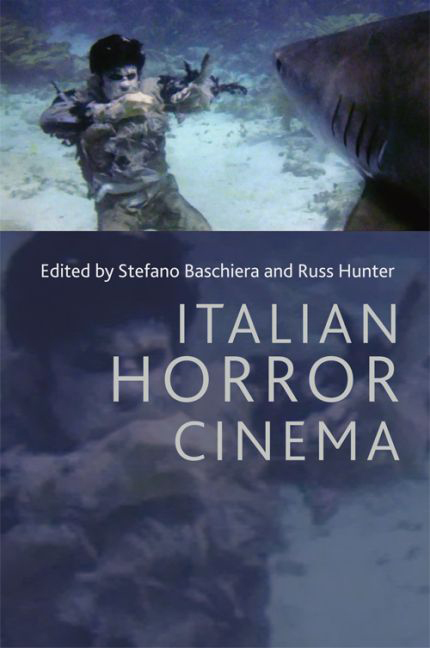Book contents
- Frontmatter
- Contents
- List of figures
- List of contributors
- Acknowledgements
- Introduction
- 1 Preferisco l'inferno: early Italian horror cinema
- 2 Domestic films made for export: modes of production of the 1960s Italian horror film
- 3 The 1980s Italian horror cinema of imitation: the good, the ugly and the sequel
- 4 Knowing the unknown beyond: ‘Italianate’ and ‘Italian’ horror cinema in the twenty-first century
- 5 Bavaesque: the making of Mario Bava as Italian horror auteur
- 6 The Argento Syndrome: aesthetics of horror
- 7 Scrap metal, stains, clogged drains: Argento's refuse and its refusals
- 8 The giallo /slasher landscape: Ecologia del delitto, Friday the 13th and subtractive spectatorship
- 9 Kings of terror, geniuses of crime: giallo cinema and fumetti neri
- 10 Political memory in the Italian hinterland: locating the ‘rural giallo’
- 11 The horror of progressive rock: Goblin and horror soundtracks
- 12 ‘The only monsters here are the filmmakers’: animal cruelty and death in Italian cannibal films
- 13 Italian horror cinema and Italian film journals of the 1970s
- Index
5 - Bavaesque: the making of Mario Bava as Italian horror auteur
Published online by Cambridge University Press: 12 September 2017
- Frontmatter
- Contents
- List of figures
- List of contributors
- Acknowledgements
- Introduction
- 1 Preferisco l'inferno: early Italian horror cinema
- 2 Domestic films made for export: modes of production of the 1960s Italian horror film
- 3 The 1980s Italian horror cinema of imitation: the good, the ugly and the sequel
- 4 Knowing the unknown beyond: ‘Italianate’ and ‘Italian’ horror cinema in the twenty-first century
- 5 Bavaesque: the making of Mario Bava as Italian horror auteur
- 6 The Argento Syndrome: aesthetics of horror
- 7 Scrap metal, stains, clogged drains: Argento's refuse and its refusals
- 8 The giallo /slasher landscape: Ecologia del delitto, Friday the 13th and subtractive spectatorship
- 9 Kings of terror, geniuses of crime: giallo cinema and fumetti neri
- 10 Political memory in the Italian hinterland: locating the ‘rural giallo’
- 11 The horror of progressive rock: Goblin and horror soundtracks
- 12 ‘The only monsters here are the filmmakers’: animal cruelty and death in Italian cannibal films
- 13 Italian horror cinema and Italian film journals of the 1970s
- Index
Summary
In 2007 the writer/critic Tim Lucas published Mario Bava: All the Colors of the Dark. This massive tome, glossily produced, extensively illustrated, and over 1,100 pages long, has since been described, with some justification, as ‘one of the most impressive books ever to have been written about any director’ (Williams, 2011: 162). The end result of over thirty years’ research, Mario Bava: All the Colors of the Dark has served to underline, reinforce and possibly clinch once and for all Mario Bava's status as a major figure not merely in Italian horror cinema but in world horror as well. However, such status has been bestowed entirely retrospectively, for during his directorial career – which ran from 1960 through to the mid-1970s – Bava, while a respected figure in the Italian film industry, received little critical attention and was not generally known to the film-going public, either in his native Italy or elsewhere.
In Mario Bava: All the Colors of the Dark, Lucas ascribes this obscurity to Bava's own modesty and dislike of publicity. Notwithstanding the idiosyncrasies of personality, the national and generic contexts within which Bava operated were also not especially amenable to the promotion of the director as a key creative figure or as being in any other way of importance. Indeed, horror cinema as it existed internationally from the 1930s through to the 1970s produced few ‘star’ directors who generated any kind of critical following or whose names featured prominently in movie publicity. In their own distinctive ways James Whale, director of the horror classics Frankenstein (1931) and Bride of Frankenstein (1935), the self-publicising William Castle in the 1950s and 1960s, and (in as much as he was a horror director) Alfred Hitchcock were notable exceptions, but the majority of horror directors laboured unobtrusively behind the scenes. Often they were figures, like Bava, who had worked their way up through the film industry over a period of years or decades and, again like Bava, who did not restrict themselves to the horror genre but operated in a variety of other genres as well.
- Type
- Chapter
- Information
- Italian Horror Cinema , pp. 79 - 92Publisher: Edinburgh University PressPrint publication year: 2016

